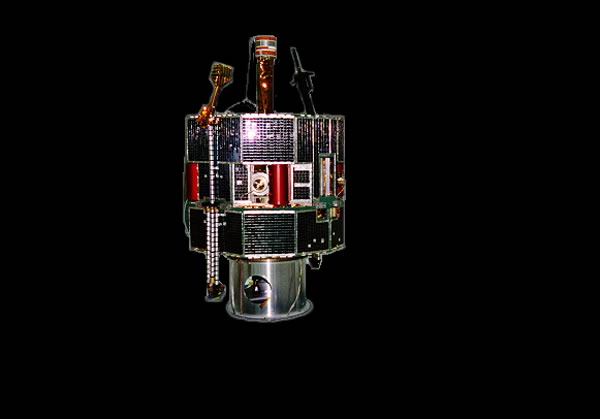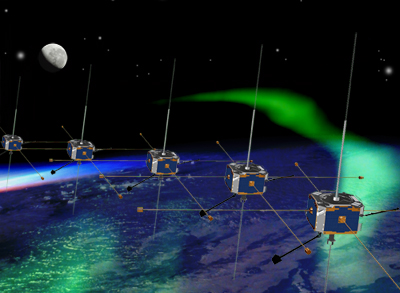Spacecraft Studies of Aurorae
The Polar spacecraft was launched in February of 1996 to obtain data from both high- and low-altitude perspectives of the active polar regions of space near Earth. In its polar orbit around the Earth, the satellite also passes nearer the equator through the Earth’s trapped radiation, the Van Allen belts.
VISUAL 25 (still): POLAR Spacecraft

Optional Information about POLAR Using the spacecraft, we study particles of the solar wind both high above the poles and at lesser altitudes where energy is transferred from electric fields and electromagnetic waves to electrons that then plunge into the atmosphere to create the aurora. The satellite detects the flow of particles from the Earth’s upper atmosphere into the magnetosphere and particles and energy flow from the magnetotail back into the atmosphere.
VISUAL 26 (still): FAST Spacecraft

The Fast Auroral SnapshoT (FAST) explorer, launched in August of 1996, studies the details of the Earth’s auroral regions. Several ground support “campaigns” coordinated satellite measurements with ground observations of the aurora borealis from locations in Alaska and Sweden.
Optional Information about FAST FAST is in an elliptical polar orbit (400 by 4000 km). The science instruments on board FAST measure the magnetic and electric fields in the upper atmosphere, as well as particles’ mass, charge, and velocity in order to determine their origin. This information allows scientists to learn about the interaction of the solar wind with the Earth’s magnetosphere. Science instruments on the spacecraft were conceived and designed by a team of collaborators from across the country: the Space Sciences Lab on the campus of the University of California at Berkeley, the University of New Hampshire, Lockheed PA (for the TEAMS), UCLA, and Los Alamos.
VISUAL 27 (still): IMAGE Spacecraft

The Imager for Magnetopause-to-Aurora Global Exploration (IMAGE) mission is the first satellite mission dedicated to imaging the region of space controlled by the Earth’s magnetic field—the Earth’s magnetosphere and the effects of the solar wind on the Earth’s magnetosphere.
Optional Information about IMAGE IMAGE was launched in March, 2000. In the magnetosphere, invisible to traditional astronomical observing techniques, there are ionized atoms and electrons. IMAGE employs a variety of imaging techniques to “see the invisible” and to produce the first-ever global images of the magnetosphere. The IMAGE mission addresses questions such as:How are particles injected into the magnetosphere on the time scales of substorms and geomagnetic storms? How does the magnetosphere respond to changes in the solar wind?
VISUAL 28 (still): THEMIS Spacecraft

[Fade off images.]
The Time History of Events and Macroscale Interactions during Substorms (THEMIS) spacecraft launched in February of 2007. The mission had 5 identical spacecraft whose orbits lined up once every 4 days. One of THEMIS’s key discoveries overturned a long-standing belief about how and when most of the solar particles penetrate Earth’s magnetic field. We have seen how Earth’s magnetic field acts as a shield against the solar wind particles. However, our magnetic field is a leaky shield and the number of particles breaching this shield depends on the orientation of the sun’s magnetic field. It had been thought that when the sun’s magnetic field is aligned with that of the Earth, the door is shut and that few if any solar particles enter Earth’s magnetic shield. The door was thought to open up when the solar magnetic field direction points opposite to Earth’s field, leading to more solar particles inside the shield.
VISUAL 29 (optional movie): THEMIS Discovery Observations by the THEMIS spacecraft fleet demonstrate that the opposite is true. Twenty times more solar particles cross the Earth’s leaky magnetic shield when the Sun’s magnetic field is aligned with that of the Earth compared to when the two magnetic fields are oppositely directed. NASA has extended the THEMIS mission to the year 2012. In addition, ARTEMIS, a new mission that will take the two outer THEMIS probes into lunar orbits and perform solar wind, magnetotail, and lunar science. [Fade off movie of THEMIS Discovery.]
The most spectacular images of the Sun that we see today come from the SOHO and TRACE spacecraft. You can view many splendid images of the Sun by visiting the Websites of those satellite missions.

